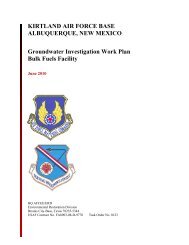Final FONSI and EA for hot cargo pad on Kirtland AFB - Kirtland Air ...
Final FONSI and EA for hot cargo pad on Kirtland AFB - Kirtland Air ...
Final FONSI and EA for hot cargo pad on Kirtland AFB - Kirtland Air ...
Create successful ePaper yourself
Turn your PDF publications into a flip-book with our unique Google optimized e-Paper software.
<str<strong>on</strong>g>Final</str<strong>on</strong>g> <str<strong>on</strong>g>EA</str<strong>on</strong>g> Addressing C<strong>on</strong>structi<strong>on</strong>, Operati<strong>on</strong>, <str<strong>on</strong>g>and</str<strong>on</strong>g> Maintenance of a Hot Cargo Pad<br />
C<strong>on</strong>structi<strong>on</strong> of the proposed <str<strong>on</strong>g>hot</str<strong>on</strong>g> <str<strong>on</strong>g>cargo</str<strong>on</strong>g> <str<strong>on</strong>g>pad</str<strong>on</strong>g> would overlap into <strong>on</strong>e ERP site, WP-26, east of Pad 5. WP-<br />
26 c<strong>on</strong>sists of two ab<str<strong>on</strong>g>and</str<strong>on</strong>g><strong>on</strong>ed sewage lago<strong>on</strong>s that are surrounded by berms <str<strong>on</strong>g>and</str<strong>on</strong>g> a locked fence. The<br />
lago<strong>on</strong>s were c<strong>on</strong>structed from local material in 1962 <str<strong>on</strong>g>and</str<strong>on</strong>g> were unlined. Elevated levels of silver,<br />
benzo(a)pyrene, <str<strong>on</strong>g>and</str<strong>on</strong>g> TCE c<strong>on</strong>taminati<strong>on</strong> have been identified at WP-26 due to its historical use as settling<br />
p<strong>on</strong>ds <str<strong>on</strong>g>for</str<strong>on</strong>g> residential <str<strong>on</strong>g>and</str<strong>on</strong>g> light industrial raw sewage waste generated at Kirtl<str<strong>on</strong>g>and</str<strong>on</strong>g> <strong>AFB</strong>. These historical<br />
lago<strong>on</strong>s were in service from 1962 to 1987 (K<strong>AFB</strong> 2008a, K<strong>AFB</strong> 2008e).<br />
Initial sampling occurred in 2002 <str<strong>on</strong>g>and</str<strong>on</strong>g> 2003, <str<strong>on</strong>g>and</str<strong>on</strong>g> identified TCE <str<strong>on</strong>g>and</str<strong>on</strong>g> 1,1-dichloroethene (DCE) at levels<br />
above the minimum detecti<strong>on</strong> c<strong>on</strong>centrati<strong>on</strong> in soil vapor samples from 50 to 200 feet below ground<br />
surface (bgs). Additi<strong>on</strong>ally, TCE was detected in perched groundwater samples above the USEPA<br />
Maximum C<strong>on</strong>taminant Level (MCL) of 5 micrograms per liter (µg/L). Subsequent sampling associati<strong>on</strong><br />
associated with a RCRA Facility Investigati<strong>on</strong> (RFI) from 2004 through 2006 revealed soil vapor<br />
sampling of TCE, DCE, <str<strong>on</strong>g>and</str<strong>on</strong>g> acet<strong>on</strong>e at c<strong>on</strong>centrati<strong>on</strong>s significantly above the minimum detecti<strong>on</strong><br />
c<strong>on</strong>centrati<strong>on</strong>. Perched groundwater (from approximately 200 feet bgs) samples were collected under the<br />
RFI c<strong>on</strong>firming that TCE was the <strong>on</strong>ly c<strong>on</strong>stituent of c<strong>on</strong>cern detected above its USEPA MCL (K<strong>AFB</strong><br />
2008e).<br />
Soil sampling occurred separately from 2006 to 2007. The sampling event delineated the thickness of<br />
sewage sludge <str<strong>on</strong>g>and</str<strong>on</strong>g> effect the sludge had <strong>on</strong> subsurface soils to a depth of 5 feet. This investigati<strong>on</strong> found<br />
several metals at elevated c<strong>on</strong>centrati<strong>on</strong>s in the sewage sludge. Laboratory testing c<strong>on</strong>firmed that<br />
chromium identified in the samples was not hexavalent chromium (the most toxic <str<strong>on</strong>g>for</str<strong>on</strong>g>m). The sampling<br />
data were utilized to compile an Ecological <str<strong>on</strong>g>and</str<strong>on</strong>g> Human Health Risk Assessment. The c<strong>on</strong>clusi<strong>on</strong>s of the<br />
assessment stated that silver in the sewage sludge was the <strong>on</strong>ly metal likely to create an ecological hazard.<br />
C<strong>on</strong>currently, benzo(a)pyrene in the sludge-soil mixed layer was identified as the sole human health<br />
potential carcinogen risk (K<strong>AFB</strong> 2008a).<br />
To address the potential risks identified in the Ecological <str<strong>on</strong>g>and</str<strong>on</strong>g> Human Health Risk Assessment Report, a<br />
remedial acti<strong>on</strong> c<strong>on</strong>sisting of removal of the top 5 inches of sewage sludge will be c<strong>on</strong>ducted in Spring<br />
2010 (Holmes 2009).<br />
Four MMRP sites (SR763, SR764, <str<strong>on</strong>g>and</str<strong>on</strong>g> SR767 Rifle Ranges <str<strong>on</strong>g>and</str<strong>on</strong>g> the SR766 Sub-Machine Gun Range)<br />
have been identified as overlapping with the existing <str<strong>on</strong>g>hot</str<strong>on</strong>g> <str<strong>on</strong>g>cargo</str<strong>on</strong>g> <str<strong>on</strong>g>pad</str<strong>on</strong>g> (Pad 5) <str<strong>on</strong>g>and</str<strong>on</strong>g> the proposed <str<strong>on</strong>g>hot</str<strong>on</strong>g> <str<strong>on</strong>g>cargo</str<strong>on</strong>g><br />
<str<strong>on</strong>g>pad</str<strong>on</strong>g> site. The historical <str<strong>on</strong>g>and</str<strong>on</strong>g> revised historical range boundaries <str<strong>on</strong>g>for</str<strong>on</strong>g> SR763, SR764, <str<strong>on</strong>g>and</str<strong>on</strong>g> SR766, <str<strong>on</strong>g>and</str<strong>on</strong>g> the<br />
revised historical range boundary <str<strong>on</strong>g>for</str<strong>on</strong>g> SR767 overlap with the Proposed Acti<strong>on</strong> area. Phase I surveys were<br />
c<strong>on</strong>ducted <str<strong>on</strong>g>for</str<strong>on</strong>g> these ranges, <str<strong>on</strong>g>and</str<strong>on</strong>g> expended small arms cartridges <str<strong>on</strong>g>and</str<strong>on</strong>g> links were discovered at SR764<br />
during the survey. No other MCs were identified at these ranges. Although, it was determined that<br />
SR766 <str<strong>on</strong>g>and</str<strong>on</strong>g> SR767 were not surveyed because discrepancies in the locati<strong>on</strong>s <str<strong>on</strong>g>and</str<strong>on</strong>g> boundaries of SR766 <str<strong>on</strong>g>and</str<strong>on</strong>g><br />
SR767 were identified after completi<strong>on</strong> of the surveys. All four MMRP sites are listed as category G <str<strong>on</strong>g>for</str<strong>on</strong>g><br />
human health, chemical warfare, <str<strong>on</strong>g>and</str<strong>on</strong>g> explosive hazard. This hazard classificati<strong>on</strong> category corresp<strong>on</strong>ds<br />
with a minimal potential <str<strong>on</strong>g>for</str<strong>on</strong>g> exposure. It is not anticipated that these areas c<strong>on</strong>tain Muniti<strong>on</strong>s <str<strong>on</strong>g>and</str<strong>on</strong>g><br />
Explosives of C<strong>on</strong>cern (MEC); however, due to their historical use as firing ranges, there is a potential <str<strong>on</strong>g>for</str<strong>on</strong>g><br />
MC c<strong>on</strong>taminati<strong>on</strong> (USACE 2007).<br />
Asbestos-C<strong>on</strong>taining Material. Asbestos is regulated by the USEPA under the CAA, TSCA, <str<strong>on</strong>g>and</str<strong>on</strong>g><br />
Comprehensive Envir<strong>on</strong>mental Resp<strong>on</strong>se, Compensati<strong>on</strong>, <str<strong>on</strong>g>and</str<strong>on</strong>g> Liability Act (CERCLA). The USEPA has<br />
established that any material c<strong>on</strong>taining more than 1 percent asbestos is c<strong>on</strong>sidered an ACM. Friable<br />
ACM is any material c<strong>on</strong>taining more than 1 percent asbestos, <str<strong>on</strong>g>and</str<strong>on</strong>g> that, when dry, can be crumbled,<br />
pulverized, or reduced to powder by h<str<strong>on</strong>g>and</str<strong>on</strong>g> pressure. N<strong>on</strong>friable ACM is any ACM that does not meet the<br />
criteria <str<strong>on</strong>g>for</str<strong>on</strong>g> friable ACM. There are no records of ACMs at the Proposed Acti<strong>on</strong> site.<br />
Kirtl<str<strong>on</strong>g>and</str<strong>on</strong>g> <strong>AFB</strong>, NM January 2011<br />
3-34
















